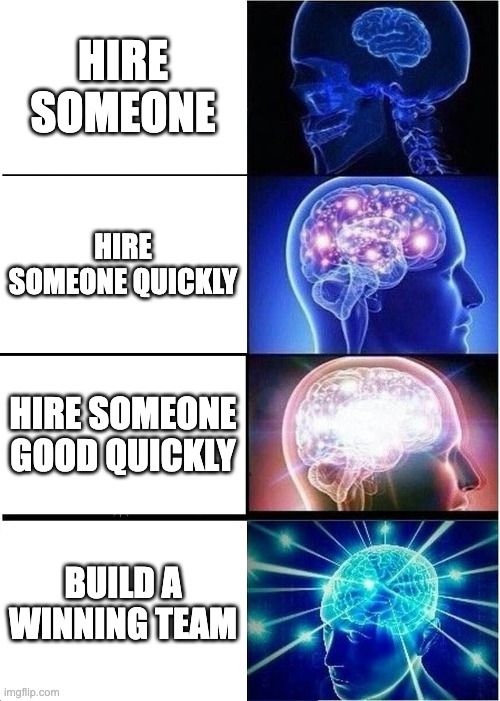Kevin Wheeler wrote a fantastic piece in his Future of Talent Weekly Newsletter called The Theory of Constraints Applied to Recruiting. In it, he — inspired by Eli Goldratt’s Theory of Constraints — provides a lucid and persuasive argument for why recruiters and team builders should think of their hiring process as a system, and focus on breaking the single largest constraint in the system before moving on to the next one.
It’s a great piece, correct (to my mind) in many ways, and I strongly recommend you read it. But, it got me thinking about when is it helpful to draw a comparison between manufacturing processes and recruiting processes, and at what point the comparison breaks and, therefore, stops being useful? The breaking points are worth being aware of because they improve our depth of understanding of how a world-class recruiting function really operates.
(It’s worth noting at this point that my thinking on this topic is focused on knowledge worker recruiting. It may not apply to other types of recruiting.)
1. In recruiting, there are no commodities.
Manufacturing involves taking well understood, standardized raw materials and putting them through a well understood, standardized process in order to create a highly-specified output. In this context, it makes sense to drive for efficiency, because the cheaper you can produce your item, the cheaper you can price it, and the more of the market you can win. Difficult to achieve, but simple to quantify.
But in recruiting:
- The equivalent of the raw material is the candidate. They are humans. Highly complex and unique. The opposite of well understood and standardized.
- The process is highly reliant on humans, mainly in the form of hiring managers, interviewers and other assessors.
- Most importantly, the output (a good candidate that is likely to accept an offer) is not highly-specified. It is loosely-specified, because hiring teams know that humans are unique. Specifying every detail would make it impossible to hire anyone.
Not being able to define every detail of the inputs, the process, or the output makes recruiting fundamentally different from manufacturing. It means the system you build for hiring is harder to read than a manufacturing system, and much less predictable. What may appear to be a constraint today may well not be tomorrow. For example, a sourcer may have a run of bad luck and reach out to a bunch of people that are not looking to move on, then come across a pool of folks that are more open to moving. Suddenly the constraint has moved despite no reallocation of effort or resources. It just moved because people (in this case, prospective candidates) are all different from each other.
With the lack of predictability of the system in mind, recruiters need to be careful about committing a large amount of effort to break something that appears to be a constraint but actually isn’t.
2. In recruiting, you can and should be flexible on what you're looking for.
In manufacturing, systems are designed around the idea of churning out lots of the same thing at high volume. This is for the same reason mentioned above: it enables the manufacturer to sell their goods at a cheaper price while still making a profit.
In recruiting, your idea of an ideal candidate should change relatively frequently. Either because you have made hires that have changed the balance of your team, or because time has passed, strategies have been updated, and the business needs are different. You should also be open to hiring a different type of candidate than you initially planned, and adapting your go-forward hiring plan accordingly to accommodate this.
All in all, recruiting just has a tonne more judgement involved than manufacturing. Being able to adapt what you’re looking for in a good candidate is an additional layer of complexity (and opportunity) in the process that is not present in manufacturing.
3. In recruiting, the goal is to build winning teams. Not a conveyor belt of hires.
Eli Goldratt’s other seminal book (on the same topic) is called The Goal. The idea of the book is that, by having a sufficiently deep understanding of the goal of a system, you are better placed to operate it effectively. In his piece, Kevin writes:
If we think of recruiting as a chain, starting with creating a desire to work for a firm and ending with a new employee, any step in this chain could limit the ability to hire quickly.”
Based on this, it appears the goal he has in mind for the recruiting system is to “hire quickly”. While that may be the pressure that recruiting teams and hiring managers feel day-to-day, it is not truly the goal of recruiting. The goal of recruiting is to build winning teams.

It is incumbent on recruiters to act as talent advisors to the team builders they work shoulder-to-shoulder with. That means understanding the unique needs of the team, designing hiring systems and processes sympathetic to those needs, and providing insights and counsel when making key decisions that impact the quality of the team. They are not just there as purveyors of the candidate assembly line, hoping to get a few hires through to hit headcount targets.
In summary…
Recruiting is about more than the recruiting process. It’s about building winning teams. And without a deep and up-to-date understanding of what the team needs in order to win, you can’t really build a world-class process anyway. So while recruiters should, of course, remove the practical bottlenecks that are slowing down hiring, the best recruiters know that the largest impact they can have is to help the organization define what a winning team looks like for them, then design systems based on the data that really matters in this very-human process that is hiring.

